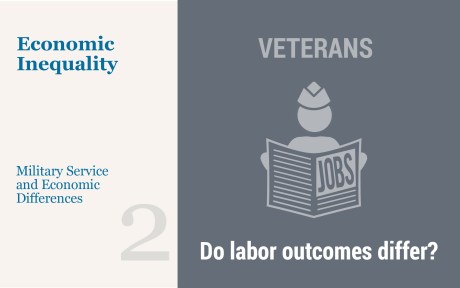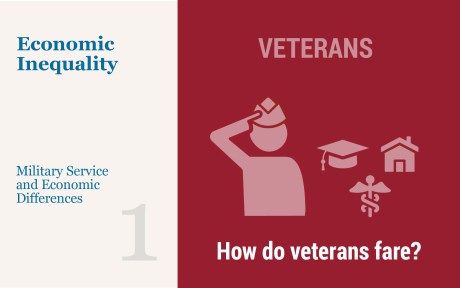
We continue our series on military service and consider veterans’ earnings and labor market outcomes. We find that veterans earn more than 12 percent less and are 4 percentage points (18 percent) more likely to be out of the labor force than comparable nonveterans. Interestingly, accounting for veterans’ differences from comparable nonveterans in terms of education and disability status largely explains these labor market differences.
As in the previous post—recognizing that veterans and nonveterans differ along many dimensions besides veteran status—we construct a comparison group of nonveterans by restricting it to male high school graduates, and reweighting them so that their distributions of age, race, ethnicity, and birthplace match those of veterans. For example, if labor force participation declines with age, then a group that is older on average will also have lower labor force participation. However, differences in labor force participation between groups with the same age distribution are more meaningful.
Veterans Less Likely to be in the Labor Force and Earn Less on Average
Employment Status
Percent
Average Labor Income
U.S. dollars, thousands
Sources: American Community Survey; authors’ calculations.
Unemployment and Earnings
We first see in the left panel that, relative to comparable nonveterans, veterans have lower employment rates, driven by lower labor force participation. In the 2019 five-year American Community Survey (ACS)—the last one before the onset of the COVID-19 pandemic—75 percent of veterans were employed, compared to 79 percent of comparable nonveterans (the employment rate for the general population at the time was around 80 percent). Do veterans have lower employment rates because they are looking for jobs but can’t find them (unemployment) or because they aren’t even looking for jobs (nonparticipation)? The answer is emphatically the latter. Unemployment rates for both veterans and comparable nonveterans were equal at about 3 percent. On the other hand, 22 percent of veterans were out of the labor force, compared with only 18 percent of comparable nonveterans. Relative to a comparable nonveteran, a veteran is about 22 percent more likely to be out of the labor force.
Next, we see that veterans earn less on average than nonveterans. On average, in the 2019 five-year ACS, veterans earned $51,900 per year, while comparable nonveterans earned $59,200—over $7,000 more per year, or over 12 percent more. Although part of this difference is accounted for by lower labor market participation among veterans, if working veterans and nonveterans earned the same wages, the labor force participation difference would explain less than half of the earnings differential.
Education and Disability Differences Mostly Explain Participation Gap
Veteran LFP gap, percent
Labor Force Participation
In the opening post of this series, we showed that relative to comparable nonveterans, veterans have lower educational attainment and are more likely to have disabilities. Can these disparities explain the labor market differences we observe here? In the chart above, the leftmost bar shows the unconditional (raw) difference in labor force participation rates for veterans vs. comparable nonveterans—nearly 4 percentage points. The next bar to the right shows this difference accounting for the fact that veterans are much more likely to be disabled than comparable nonveterans. The differential drops by half, to less than 2 percentage points.
The subsequent bar shows the labor force participation difference now accounting for the fact that veterans are less likely to have college and advanced degrees than nonveterans, but not accounting for the disability difference. This is to see whether and how much education, separate from disabilities, can explain labor force participation differentials. The differential accounting for educational differences is lower than the unconditional one, but by less than we saw when accounting for disabilities, about 3 percentage points. Finally, the rightmost bar shows the difference when both education and disability status is accounted for. Conditional on education and disability status, veterans continue to participate in the labor force less than comparable nonveterans do but by a much smaller margin, only 1 percentage point.
Education and Disability Differences Mostly Explain Earnings Gap
Veteran income gap, U.S. dollars
We see a similar picture when looking at earnings. The unconditional earnings difference, as discussed above, is roughly $7,000. Accounting for differences in disability status between veterans and nonveterans reduces this gap to slightly under $5,000. Accounting for differences in educational attainment (but not disability status) results in an even larger reduction in this gap, to less than $4,000. This is unlike the picture we had with labor force participation, where disability status rather than educational attainment was a stronger factor playing into the veteran-nonveteran difference. Finally, accounting both for differences in education and in disability status between veterans and comparable nonveterans decreases the earnings gap to under $2,000.
Our analysis does not provide causal effects of veteran status on labor market outcomes. However, it does document large disparities in labor force participation and earnings between veterans and nonveterans who are comparable along a significant number of demographic and geographic dimensions. The differences in education and disability status that we show in the previous post, however, statistically account for most of the veterans’ labor market disparities. More research is needed to look at what are the causal effects of military service on subsequent life outcomes in the post-draft era and how public policies should adjust. Additionally, take note of a new monthly product—Equitable Growth Indicators (EGI)—in which we track data relevant to outcomes by race/ethnicity, gender, income, age, veteran status, and geography. The charts and brief takeaways shed light on disparities in people’s experience of inflation, earnings, employment, and consumer spending.

Rajashri Chakrabarti is the head of Equitable Growth Studies in the Federal Reserve Bank of New York’s Research and Statistics Group.

Dan Garcia is a research analyst in the Federal Reserve Bank of New York’s Research and Statistics Group.

Maxim Pinkovskiy is an economic research advisor in Equitable Growth Studies in the Federal Reserve Bank of New York’s Research and Statistics Group.
How to cite this post:
Rajashri Chakrabarti, Dan Garcia, and Maxim Pinkovskiy, “Do Veterans Face Disparities in the Labor Market—And What Accounts for Them?,” Federal Reserve Bank of New York Liberty Street Economics, May 25, 2023, https://libertystreeteconomics.newyorkfed.org/2023/05/do-veterans-face-disparities-in-the-labor-market-and-what-accounts-for-them/
BibTeX: View |
Disclaimer
The views expressed in this post are those of the author(s) and do not necessarily reflect the position of the Federal Reserve Bank of New York or the Federal Reserve System. Any errors or omissions are the responsibility of the author(s).












 RSS Feed
RSS Feed Follow Liberty Street Economics
Follow Liberty Street Economics